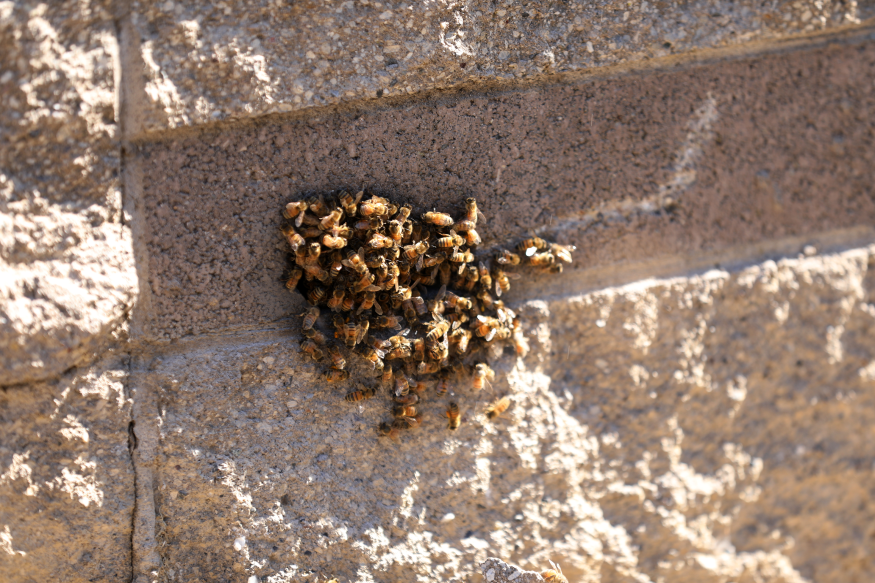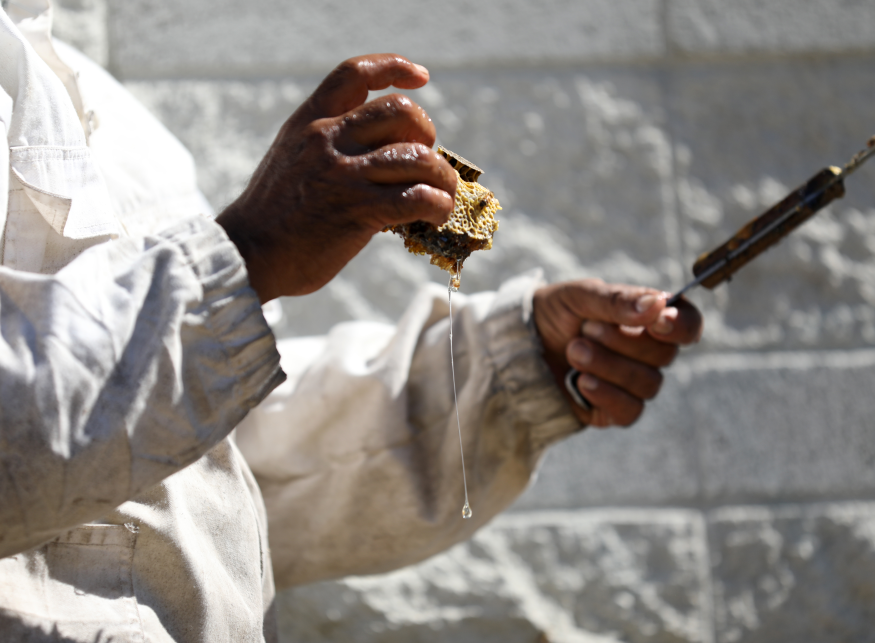Local beekeeper makes honey with bees removed from BART property, protecting riders and helping to preserve the critical insect
If you passed by the four-inch notch in the wall on Bailey Road next to BART’s Pittsburg/Bay Point Station, you probably wouldn’t notice a thing. But if you took a closer look – not too close – you’d find a hive of hundreds of buzzing honeybees. The notch in the wall seemed like a keyhole into another world – one of order and organization, where the queen rules all and the honeycomb drips with its workers’ spoils.
Every now and then, a hive of bees crops up on BART property. Rather than exterminating the hive, BART brings in beekeeper Khaled Almaghafi to painstakingly remove the hive and relocate it. He makes and sells the honey produced from the thousands of bees he tends to (some of which once lived on BART property) at Bee Healthy Honey Shop in Oakland.
You might not be thinking about bees during your BART commute, but the groundskeepers at BART are constantly keeping an eye out for hives on our property. We can’t keep the hives in place as bees pose a threat to riders and community members with potentially life-threatening allergies, explained George DeOcampo, BART Facilities Maintenance Supervisor.
“We remove them because it can be a hazard,” DeOcampo said.
We intentionally relocate the hives rather than exterminating the bees, DeOcampo said, because BART recognizes the importance of preserving this environmentally critical insect. By relocating the bees to Almaghafi’s hives, BART is protecting its riders and helping to protect the animal. (Wasps and yellowjackets are another story. BART brings in local vector control to remove these insects from its property.)

Bees are in Almaghafi’s blood. The Bay Area resident has been working with the insects since he was five years old in Yemen, where his father and grandfather tended hives.
“I grew up with bees,” he said before suiting up and diagnosing the Bailey Road hive, composed of Apis melifera ligustica – Italian honeybees. Almaghafi’s license plate reads, “Bees 2.” A bumper sticker on his red truck says, “Beekeepers Are Real Honeys.” He’s a talented beekeeper, and he’s got a sense of humor about it.
“In Yemen, everyone likes bees and honey. It’s medicine,” he said. “If people see a bee swarm in Yemen, they chase after it. Not like here.”
Almaghafi moved to the U.S. in 1986, working in restaurants, bakeries, and gas stations. He moved to California “because everyone in Yemen knows that California is [a] good environment for agriculture and bees,” his website explains. Almaghafi wanted to study bees at UC Davis, but he couldn’t afford it, so he went to work to support his wife and two small children.

Around 1992, while serving as a gas station clerk, an unsatisfied Almaghafi looked up bee removal in the Yellow Pages. He found a beekeeper near his Oakland home and asked to tag along on the jobs. The beekeeper said agreed.
Almaghafi went on to found a bustling business, removing bees and making honey with his 100-plus hives in Oakland, Santa Clara, El Sobrante, and Richmond. He sells multiple varieties of honey – orange, chestnut, sage, turmeric – along with raw honeycomb, candles, and other goods, from his storefront in Oakland as well as his website.
For Almaghafi, bees are a spiritual calling. When asked why the Bailey Road hive had clustered in a hole in the wall, he noted that there’s “a whole chapter in the Holy Quran that says God told the bees to go in the mountains, in the cliffs, in the trees, and in human beings’ structures.” The scripture conveys a scientific fact – if you build it, the bees will come.

During the Bailey Road hive removal, Almaghafi began by donning a white coat and bee veil. He then set out sweet smelling smoke in a silver canister – a balm for the bees that calms them.
Almaghafi next used a small electric hand saw to slice open a brick in the wall, about four feet above the notch in the wall. In this spot, Almaghafi had a feeling he’d find the hive’s honeycomb – hexagonal wax structures that houses honey, pollen, and larvae. Remove the honeycomb, Almaghafi said, and the bees will not return to this location.
After sawing through the brick, a fearless Almaghafi plunged his bare hands and arms about a foot inside the hollowed wall. Bees buzzed around his face, not fazing him.
“The honeycomb,” he said with confidence, “is here.”
He pulled out the waxen honeycomb, gently setting aside the larvae that will soon grow into honey-making bees, and went at the hive with a very gentle vacuum attached to a white bucket. With care, Almaghafi stuck the vacuum, which does not harm the bees, into the wall and sucked the insects out. Each time a bucket filled, Almaghafi lidded it and brought out another.

“It’s a hollow wall,” Almaghafi said, his left arm fully submerged. “The bees could be going up as far as four or five feet.”
Honeybees play a major role in supporting earthen animal and plant life. As major pollinators of food crops, bees are a significant player in global ecology.
Climate change and the use of certain pesticides have decreased bee populations throughout the world in recent years. Though honeybees are not listed as “endangered” under the Endangered Species Act of 1973, many native bees are listed.
There are steps the average individual can take to help the bees, Almaghafi said.
“Stop spraying chemicals in your backyard and plant flowers that benefit the bees,” he said. Some bee-friendly plants include annuals such as honeysuckle, sunflower, and salvia, and herbs, such as sage, thyme, and lavender.
As for Almaghafi, he said he hopes to one day travel the world and tell it the stories of bees. He also offered the following reminder with a wink: “Support your local beekeepers and buy their honey.”